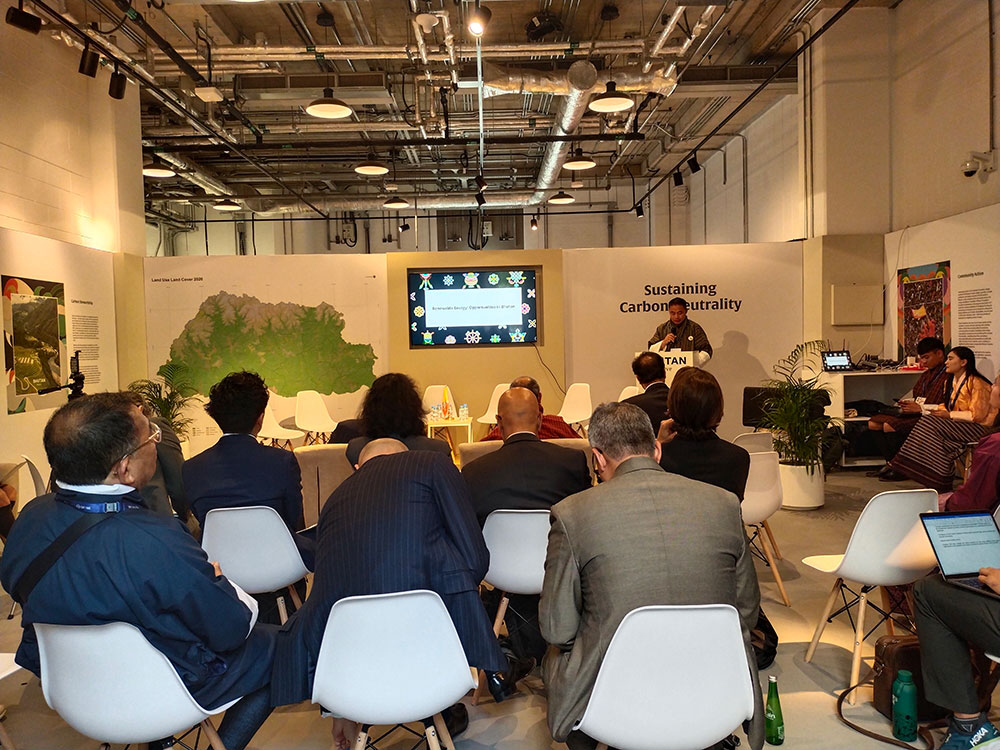YK Poudel
Dubai, UAE—As Bhutan commits to advancing the development of a green economy, it unveiled the Green Hydrogen Roadmap on December 5 at the ongoing Bhutan Pavilion in Dubai.
Bhutan committed to carbon neutrality in the United Nations Framework Convention on Climate Change (UNFCCC) in 1992.
At COP15 in 2009, Bhutan declared its commitment to carbon neutrality, a promise that was reiterated in its NDCs in 2015. The second NDC in 2021 reinstates carbon neutrality through low-emission development strategies in food security, human settlements, and surface transportation.
The roadmap is part of Bhutan’s commitment to advancing the development of a green hydrogen economy to meet its energy and climate goals.
Green hydrogen is considered to be the cleanest and most sustainable energy source that can produce electricity, power industry, and enable transportation. It doesn’t generate any polluting emissions into the atmosphere.
Outlining the expert advisory groups and creating an investment packet to promote green hydrogen projects in Bhutan, the roadmap sets a goal for hydrogen pilot projects and plans to match hydrogen generation with demand. Further, demonstrates the nation’s energy strategy at a global scale.
Director for the Department of Energy, Ministry of Energy and Natural Resources, Karma P Dorji said that Bhutan has been able to launch the future of the green hydrogen roadmap to the larger world at the COP and pursue the energy for the future. “This in the long run will provide a tremendous economic opportunity for our economy.”
“The roadmap outlines phased targets for hydrogen pilot projects, aligning generation capacity with demand growth. It establishes expert advisory groups, coordinates stakeholders and creates an investment outreach packet for green hydrogen projects in Bhutan,” he said.
The plan, according to him, highlights opportunities and showcases a strategy for enhancing the energy value chain domestically and in the global market through the green hydrogen initiative.
The roadmap will detail the necessary procedures and milestones for the development and integration of hydrogen as a key energy carrier across numerous industries, particularly in the transportation sector. It will serve as a model for governments, industry, and stakeholders to follow to coordinate efforts and investments in the hydrogen economy.
Bhutan is well-suited for creating green hydrogen through electrolysis since it has an abundance of renewable energy sources, especially hydropower. Hydrogen fuel provides a steady and dependable source of electricity that may be used in a variety of industries, including mobility, industrial, and power generation.
Bhutan’s decision to concentrate on green hydrogen is consistent with the country’s aim of carbon neutrality and sustainable growth. The greenhouse gas inventory confirmed the country’s carbon neutral position, with emissions of 3.8 million tonnes of carbon dioxide equivalent (CO2e) in 2015, offset by sequestration of 9.4 million tonnes of CO2e. Bhutan exceeded the Paris Agreement’s carbon-neutral goal, reaching a net carbon sink balance of 5.6 million tonnes of CO2e.
Bhutan’s second Nationally Determined Contribution (NDC) describes the need for USD 3.44 billion in investments until 2030 to combat climate change and fulfil its climate goals.
According to a study, Bhutan’s energy consumption will be more than sixfold, and oil demand will be more than sevenfold by 2050, with the transportation sector being the major emitter of greenhouse gases under business-as-usual conditions. Bhutan, on the other hand, can retain its carbon neutrality until 2050 by cutting oil demand in the transportation sector and encouraging the use of electric vehicles and public transportation.
The price of hydrogen for Bhutanese customers would be determined by local market conditions, infrastructural development, and government policies supportive of the hydrogen economy, according to the department officials.
There are several advantages to using electricity for hydrogen production, including the integration of renewable energy sources and energy storage. Hydrogen production through electrolysis provides an avenue for incorporating wind and solar energy into the electricity grid.
The use of electricity for hydrogen synthesis has various advantages, including the use of renewable energy sources and energy storage. Electrolysis produces hydrogen, which can be used to integrate wind and solar energy into the power system.


